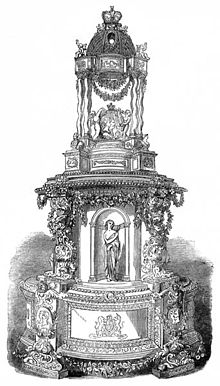Symbolism
Wedding cakes have been present at wedding ceremonies for centuries. They were not always the focus of the event and often came in different forms, like pies or bread. There has always been a lot of symbolism associated with the wedding cake. The earliest known sweet wedding cake is known as a Banbury cake, which became popular in 1655.[10] During the Roman era unsweetened barley bread was used as the wedding food and the groom would break the piece of bread in half over the brides head symbolizing “breaking of the bride’s virginal state and the subsequent dominance of the groom over her."[5] One of the most obvious symbolic traditions is the cake’s white color to symbolize virginity and purity. The white color has been attached to wedding ceremonies since the Victorian era when Queen Victoria chose to wear a white wedding dress at her wedding to Prince Albert in 1840.[11] Queen Victoria accentuated an existing symbol, the color white is frequently associated with virginity and purity. The wedding cake was originally known as the brides cake therefore the color white became common because the cake needed to reflect the bride.[5] The cutting of the cake is a task full of symbolism. The cake was originally intended to be distributed among the guests by only the bride because consuming the cake would ensure fertility.[5] As weddings grew and the number of guests increased this task became a joint venture, the groom needed to help cut the growing cake and distribute it among their guests. Layers of cakes began to pile up and the icing would need to support the weight of the cake making is very difficult for one person to cut. The groom would assist the bride in this process. Once this tradition began the bride and groom would share a piece of cake before distributing it to the guests to symbolize their union and their promise to forever provide for each other. A Banbury cake is a spiced, currant-filled, flat pastry cake simil

r to an Eccles cake, although it is more oval in shape. Once made and sold exclusively in Banbury, England, Banbury cakes have been made in the region to secret recipes since 1586 or earlier and are still made there today, although not in such quantity. The cakes were once sent as far afield as Australia, India and America. Banbury cakes were first made by Edward Welchman, whose shop was on Parsons Street.[1] Documented recipes were published by Gervase Markham and others during the 17th century. These recipes generally differ largely to the modern idea of a Banbury cake, in terms of their size, the nature of the pastry, and how the cake is made. In the late 19th century, the notorious refreshment rooms at Swindon railway station sold "Banbury cakes and pork pies (obviously stale)".[2][3] Besides currants, the filling typically includes mixed peel, brown sugar, rose water, rum, and nutmeg. Banbury cakes were traditionally enjoyed with afternoon tea.Queen Victoria (Alexandrina Victoria; 24 May 1819 – 22 January 1901) was the monarch of the United Kingdom of Great Britain and Ireland from 20 June 1837 until her death. From 1 May 1876, she used the additional title of Empress of India. Victoria was the daughter of Prince Edward, Duke of Kent and Strathearn, the fourth son of King George III. Both the Duke of Kent and King George III died in 1820, and Victoria was raised under close supervision by her German-born mother Princess Victoria of Saxe-Coburg-Saalfeld. She inherited the throne at the age of 18, after her father's three elder brothers had all died leaving no legitimate, surviving children. The United Kingdom was already an established constitutional monarchy, in which the Sovereign held relatively little direct political power. Privately, Victoria attempted to influence government policy and ministerial appointments. Publicly, she became a national icon, and was identified with strict standards of personal morality.